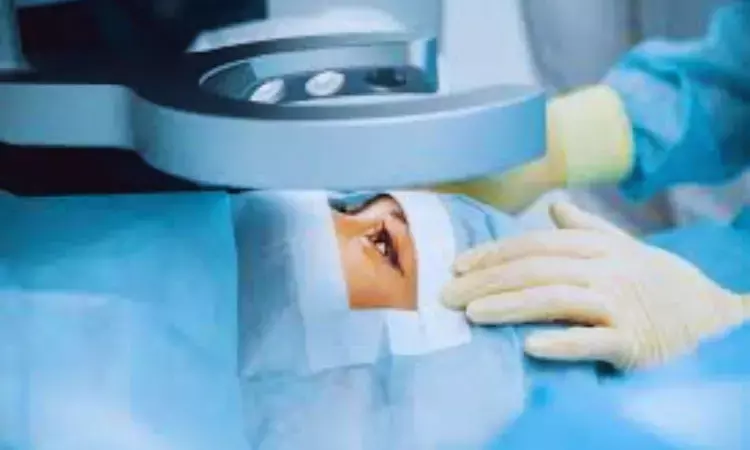- Home
- Medical news & Guidelines
- Anesthesiology
- Cardiology and CTVS
- Critical Care
- Dentistry
- Dermatology
- Diabetes and Endocrinology
- ENT
- Gastroenterology
- Medicine
- Nephrology
- Neurology
- Obstretics-Gynaecology
- Oncology
- Ophthalmology
- Orthopaedics
- Pediatrics-Neonatology
- Psychiatry
- Pulmonology
- Radiology
- Surgery
- Urology
- Laboratory Medicine
- Diet
- Nursing
- Paramedical
- Physiotherapy
- Health news
- Fact Check
- Bone Health Fact Check
- Brain Health Fact Check
- Cancer Related Fact Check
- Child Care Fact Check
- Dental and oral health fact check
- Diabetes and metabolic health fact check
- Diet and Nutrition Fact Check
- Eye and ENT Care Fact Check
- Fitness fact check
- Gut health fact check
- Heart health fact check
- Kidney health fact check
- Medical education fact check
- Men's health fact check
- Respiratory fact check
- Skin and hair care fact check
- Vaccine and Immunization fact check
- Women's health fact check
- AYUSH
- State News
- Andaman and Nicobar Islands
- Andhra Pradesh
- Arunachal Pradesh
- Assam
- Bihar
- Chandigarh
- Chattisgarh
- Dadra and Nagar Haveli
- Daman and Diu
- Delhi
- Goa
- Gujarat
- Haryana
- Himachal Pradesh
- Jammu & Kashmir
- Jharkhand
- Karnataka
- Kerala
- Ladakh
- Lakshadweep
- Madhya Pradesh
- Maharashtra
- Manipur
- Meghalaya
- Mizoram
- Nagaland
- Odisha
- Puducherry
- Punjab
- Rajasthan
- Sikkim
- Tamil Nadu
- Telangana
- Tripura
- Uttar Pradesh
- Uttrakhand
- West Bengal
- Medical Education
- Industry
Hyperosmolar patients significantly increased variation in light scatter following cataract surgery: Study

Tear film hyperosmolarity acts as a potent cellular stress on the ocular surface that can induce epithelial cell death and compromise the barrier functions of the cornea. Hyperosmolarity has been shown to be associated with significant (>1.0 diopter (D)) test-to-test variations in the measured corneal astigmatism and >0.5 D variations in IOL power, adding noise that functionally limits the resolution of keratometry and increases the likelihood of unexpected refractive error after cataract surgery.
Although prior research has shown that tear film hyperosmolarity can compromise pre-surgical measurements and impact post-surgical outcomes, it is not currently known whether hyperosmolarity is directly associated with aberrant visual sequelae. Therefore, author’s current hypothesis was that hyperosmolarity is associated with increased variation in light scatter between blinks, and specifically, that this effect is not observable under a slit lamp. If this hypothesis is correct, it would likely help to explain a portion of the phenomenon of a post-operative patient that achieves target refraction, hasan unremarkable ocular surface, but is dissatisfied with the overall quality of vision – colloquially known as the 20/20 unhappy patient.
Contiguous, 20-second objective scatter index (OSI) scans were recorded in hyperosmolar (≥320 mOsm/L) and normal subjects (<308 mOsm/L) with cataract nuclear opacity ≥3. OSI was measured at screening, baseline and 90 days following surgery. Along with symptoms of ocular surface disease, slit-lamp examination included corneal staining (0–3), tear film breakup time (TBUT) and evaluation of meibomian gland disease (MGD). An additional cohort of hyperosmolar subjects were measured for OSI at screening, baseline, and 5, 10, 15 and 30 minutes following instillation of 0.18% sodium hyaluronate (HA).
Thirty-one eyes of 31 patients were included. There was a significant difference in post-operative OSI variation when comparing hyperosmolar (0.65±0.30, N=11) to normal subjects (0.33±0.11, N=10, p=0.005). Of note, there were no significant differences in OSI variation when subjects were sorted by staining (p=0.9), TBUT (p=0.7), symptoms (p=0.7), or MGD status (p=0.9). Instillation of 0.18% HA (N=10) did not alter OSI at 5 minutes, but significant reductions in OSI of 28.8%, 38.5% and 36.7% (all p < 0.001) were observed at 10, 15 and 30 minutes.
Subjects with tear film hyperosmolarity exhibited significantly increased variation in light scatter following cataract surgery that was undifferentiated by staining or TBUT. Addition of artificial tears can acutely eliminate much of the light scatter associated with hyperosmolarity, but requires at least 15 minutes to stabilize in a hyperosmolar cohort. Elevated osmolarity may be indicative of light scatter equivalent to that of a grade 2–3 cataract.
Source: Sullivan et al; Clinical Ophthalmology 2024:18 https://doi.org/10.2147/OPTH.S484840
Dr Ishan Kataria has done his MBBS from Medical College Bijapur and MS in Ophthalmology from Dr Vasant Rao Pawar Medical College, Nasik. Post completing MD, he pursuid Anterior Segment Fellowship from Sankara Eye Hospital and worked as a competent phaco and anterior segment consultant surgeon in a trust hospital in Bathinda for 2 years.He is currently pursuing Fellowship in Vitreo-Retina at Dr Sohan Singh Eye hospital Amritsar and is actively involved in various research activities under the guidance of the faculty.


